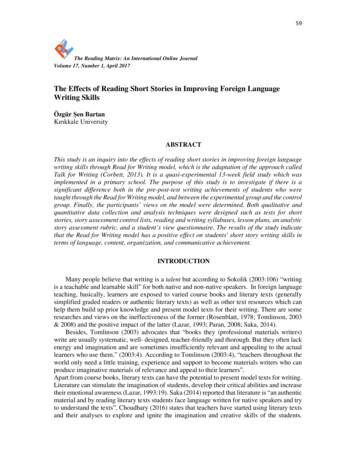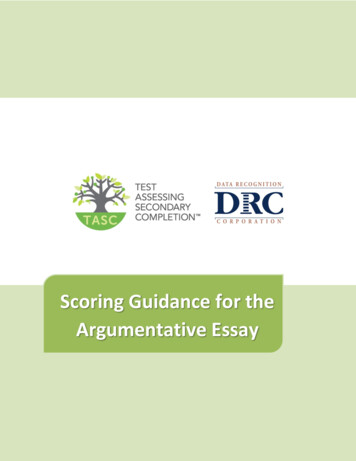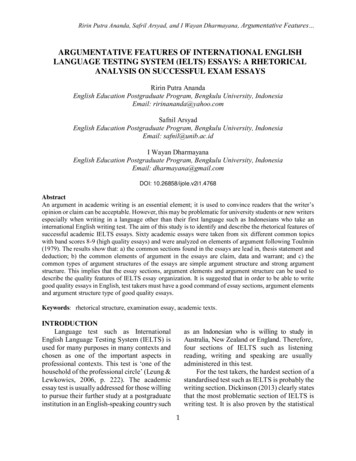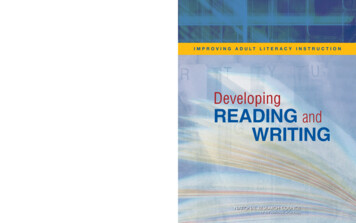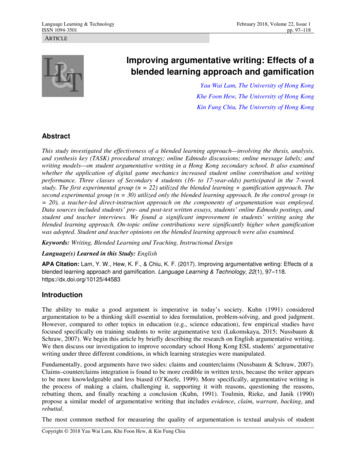
Transcription
Language Learning & TechnologyISSN 1094-3501February 2018, Volume 22, Issue 1pp. 97–118ARTICLEImproving argumentative writing: Effects of ablended learning approach and gamificationYau Wai Lam, The University of Hong KongKhe Foon Hew, The University of Hong KongKin Fung Chiu, The University of Hong KongAbstractThis study investigated the effectiveness of a blended learning approach—involving the thesis, analysis,and synthesis key (TASK) procedural strategy; online Edmodo discussions; online message labels; andwriting models—on student argumentative writing in a Hong Kong secondary school. It also examinedwhether the application of digital game mechanics increased student online contribution and writingperformance. Three classes of Secondary 4 students (16- to 17-year-olds) participated in the 7-weekstudy. The first experimental group (n 22) utilized the blended learning gamification approach. Thesecond experimental group (n 30) utilized only the blended learning approach. In the control group (n 20), a teacher-led direct-instruction approach on the components of argumentation was employed.Data sources included students’ pre- and post-test written essays, students’ online Edmodo postings, andstudent and teacher interviews. We found a significant improvement in students’ writing using theblended learning approach. On-topic online contributions were significantly higher when gamificationwas adopted. Student and teacher opinions on the blended learning approach were also examined.Keywords: Writing, Blended Learning and Teaching, Instructional DesignLanguage(s) Learned in this Study: EnglishAPA Citation: Lam, Y. W., Hew, K. F., & Chiu, K. F. (2017). Improving argumentative writing: Effects of ablended learning approach and gamification. Language Learning & Technology, 22(1), nThe ability to make a good argument is imperative in today’s society. Kuhn (1991) consideredargumentation to be a thinking skill essential to idea formulation, problem-solving, and good judgment.However, compared to other topics in education (e.g., science education), few empirical studies havefocused specifically on training students to write argumentative text (Lukomskaya, 2015; Nussbaum &Schraw, 2007). We begin this article by briefly describing the research on English argumentative writing.We then discuss our investigation to improve secondary school Hong Kong ESL students’ argumentativewriting under three different conditions, in which learning strategies were manipulated.Fundamentally, good arguments have two sides: claims and counterclaims (Nussbaum & Schraw, 2007).Claims–counterclaims integration is found to be more credible in written texts, because the writer appearsto be more knowledgeable and less biased (O’Keefe, 1999). More specifically, argumentative writing isthe process of making a claim, challenging it, supporting it with reasons, questioning the reasons,rebutting them, and finally reaching a conclusion (Kuhn, 1991). Toulmin, Rieke, and Janik (1990)propose a similar model of argumentative writing that includes evidence, claim, warrant, backing, andrebuttal.The most common method for measuring the quality of argumentation is textual analysis of studentCopyright 2018 Yau Wai Lam, Khe Foon Hew, & Kin Fung Chiu
98Language Learning & Technologyessays (Jonassen & Kim, 2010). The two main types of conceptual models for analyzing argumentationinclude (Inch & Warnick, 2002): (a) the standard models, which analyze essays according to typicalargumentation elements such as claim, counterclaim, rebuttal, and supporting data (e.g., Liu & Stapleton,2014; Nussbaum & Kardash, 2005), and (b) the more specific Toulmin-based models, which seek tofurther categorize supporting claims into grounds and warrants.Previous studies in the context of English as first language (L1) have found poor student performance inargumentative writing. For example, Crowhurst (1990) reported that young writers started their essays asan argument but then drifted into narratives that were mainly descriptive. Native English-speaking collegestudents tended to ignore opposing viewpoints when writing arguments to reason with their peers (Felton,Crowell, & Liu, 2015). Toplak and Stanovich (2003) similarly found undergraduate native Englishspeaking students generated more my-side bias (i.e., the tendency to ignore evidence against a position theperson favors). This was also affirmed in studies by other researchers (e.g., Nussbaum & Kardash, 2005;Wolfe & Britt, 2008), who found native English-speaking participants tended to present claims thatsupported their position and ignored counterclaims. Basically, research in L1 context suggests that typicalstudent weaknesses of argumentative writing include lack of support for reasons, counterclaims, andsupporting reasons for counterclaims.Second-language writing researchers have also examined the performance of second language (L2)English learners in argumentative writing, particularly in higher education contexts. Compared to L1learners, L2 learners generally face greater challenges with argumentative writing (El-Henawy, Dadour,Salem, & El-Bassuony, 2012). The first possible reason for this may be attributed to cultural background.For example, Indonesian EFL university students usually avoid giving counterarguments becausecriticizing other people, especially those of a higher social status, is considered impolite (Arsyad, 1999).Second, EFL learners may encounter greater grammatical deficiencies and limitations in vocabulary.Third, L2 learners lack knowledge of the argumentative structure (El-Henawy et al., 2012; Hirose, 2003;Liu & Stapleton, 2014). Similar to L1 writings, deficiencies in acknowledging counterarguments andrefuting them are often present in L2 learners’ arguments (Liu & Stapleton, 2014). Most EFL universitylearners in China, for example, did not supply a counter-argument section in their essays (Liu &Stapleton, 2014; Qin & Karabacak, 2010). Hirose (2003) reported that Japanese EFL learners’ experiencein argumentative writing was practically non-existent as most L2 writing instruction was oriented towardtranslation at the sentence level. El-Henawy et al. (2012) found that Egyptian EFL learners failed toconsider opposing viewpoints. This finding was supported by Rusfandi (2015), who found that a majorityof third-year Indonesian EFL learners developed a one-sided model of argumentation in their essays byfocusing only on how to state their main claims and providing relevant reasons for it.Instructional StrategiesDespite cultural and language barriers, researchers in L2 writing have argued that, with relevantinstruction, EFL students can overcome the difficulties of argumentative writing (Bacha, 2010). Sincemost of the research on L2 has been closely dependent on L1 research, L1 methods have had a significantinfluence on the development of L2 writing approaches (Myles, 2002). As such, the standard approachused by many teachers in both L1 and L2 contexts is explicit or direct instruction on argumentation (Cho& Jonassen, 2002): the setting of the lexical standards and tone, the organization of the argumentativewriting, and the assessment of arguments. Advocates of this method believe knowing that is a necessaryprerequisite for knowing how to (Crowhurst, 1990). However, research findings has shown mixed results.Several studies showed that direct instruction improved argumentative writing (e.g., Nussbaum &Schraw, 2007; Sanders, Wiseman, & Gass, 1994). Others suggested no effect (e.g., Knudson, 1994;Reznitskaya, Anderson, & Kuo, 2007).In Hong Kong, argumentative essay writing instruction similarly relies heavily on direct instruction fromteachers, with a particular focus on appropriate lexical items and essay structure. Even though studentsare encouraged to research their topics beforehand, they tend to wait for the teacher’s answers. Studentsrarely practice independent thinking (Murphy, 1987), and seldom proactively consider opposing views
Yau Wai Lam, Khe Foon Hew, and Kin Fung Chiu99from different parties. This corroborates other researchers’ observations that awareness of argumentationprinciples does not necessarily equate proficient application of these principles (e.g., Reznitskaya et al.,2007; Rusfandi, 2015).Some scholars have advocated the use of alternative methods to facilitate learner development ofargumentative writing, such as constraint-based argumentation scaffold (Cho & Jonassen, 2002), selfregulated strategy development (El-Henawy et al., 2012), model pieces of writing (Knudson, 1992;Lancaster, 2011), electronic outlining (De Smet, Broekkamp, Brand-Gruwel, & Kirschner, 2011),question prompts (Jonassen et al., 2009), or graphic organizer (Nussbaum & Schraw, 2007). Yet again,past research findings did not always show consistent positive results. For example, although graphicorganizers may help increase rebuttals (Nussbaum & Schraw, 2007), they may not necessarily enhancestudents’ critical understanding of issues (Scheuer et al., 2010). Jonassen et al. (2009) use a series ofquestion prompts (e.g., Whose perspective supports your selection? How might someone supporting theother solution disagree with your preferred solution?) to engage students in argumentation aboutengineering ethical dilemmas. The researchers found that these prompts did not help students toadequately consider and support counterclaims. Knudson (1992) found no significant differences betweeninstructions guided by model answers and unaided free-writing. De Smet et al. (2011) found that outlinewriting with Microsoft Word helped organize texts, but did not help with generating arguments.Purpose of the Study and Research QuestionsOverall, we believe that learning to write sound argumentative texts is complex. Rather than favoring onespecific method over another, we felt that a successful intervention required a careful mix of the variousmethods. The main purpose of this study was therefore to develop a relatively simple blended learningintervention that could improve the argumentative writing of secondary school students following theEnglish as a Second Language (ESL) stream. We then tested the effectiveness of this model using a quasiexperimental design on Secondary 4 (10th grade) students (16- to 17-year-olds). We also added anexpanded intervention, gamification, in one of the experimental groups in order to determine if the use ofdigital game mechanics could increase students’ online contribution and further improve theirargumentative writing. The present study was guided by the following specific questions:1. Does a blended learning approach improve student argumentative writing compared to a teacherled direct-instruction approach?2. Does a blended learning approach improve student argumentative writing compared to a blendedlearning gamification approach?3. Does a blended learning gamification approach improve student argumentative writingcompared to a control condition?4. Does the application of gamification increase student online contribution?5. How do students and teachers perceive the blended learning approach?The Blended Learning ApproachFigure 1 illustrates the blended learning approach used in this study. The various blended learningcomponents were selected based on three main theoretical perspectives of L2 writing: text modeling,process modeling, and social aspect (Barkaoui, 2007; Cumming, 2001). Text modeling aims to improveL2 argumentative writing in terms of syntax, vocabulary, and organization (Barkaoui, 2007), whileprocess modeling focuses mainly on the strategies that underlie effective writing such as the processmodel of the Toulmin argument model.
100Language Learning & TechnologyFigure 1. The blended learning model used in this study.In this study, we facilitated text and process modeling through the use of writing samples and a writingrubric. To further promote process modeling, as well as help students self-monitor and reflect on theirargumentative writing, we employed the thesis, analysis, and synthesis key (TASK) method. Central tothe social aspect is the assumption that students acquire argumentative literacy through student–teacherand student–peer interaction (Newell, Beach, Smith, & VanDerHeide, 2011). Teacher and peerinteractions can help identify weaknesses in students’ contributions and foster students’ willingness toengage in an argument (Smidt, 2002). In this study, we employed the use of online discussion throughEdmodo for students to interact with one another. We also utilized gamification in order to examinewhether it would motivate students to make more meaningful contributions in online discussions. Table 1summarizes the main components incorporated in the blended learning approach. In the followingparagraphs, we describe each blended learning component in more detail.Table 1. Summary of Blended Learning ComponentsTheoretical PerspectiveDescription of ComponentProcess ModelingUse of questions in the TASK procedural strategy to guide students to plan,write, and self-assess their argumentsSelf-MonitoringUse of message labels to classify and tag their comments during onlinediscussion; these labels included claim, opposing claim, support, evidence,rebuttal, and conclusionUse of argumentative writing rubricsUse of well- and poorly-written samplesText ModelingSocialUse of Edmodo as an online tool for peer and teacher feedbackWriting Samples and RubricWe used two types of resources to facilitate text and process modeling of argumentation skills: samples ofwell- and poorly-written essays and an argumentative writing rubric. The well- and poorly-written
Yau Wai Lam, Khe Foon Hew, and Kin Fung Chiu101argumentative texts were assessed according to the rubric of the Hong Kong Diploma of SecondaryEducation (HKDSE) examination. The three main criteria were content, language use, and essayorganization. The quality of each sample, whether well-written or poorly-written, was determined bymutual consent from at least two experienced markers of the HKDSE examination. Samples of well- andpoorly-written essays were presented so that students could acquire the syntax and lexicons, as well asanalyze the development of good versus poor writing—which we hoped would help them internalize whatto do and what not to do. Such activities help increase students’ awareness of stance-taking options andmake them more mindful of their own choices (Lancaster, 2011). A writing rubric (see Appendix A) wasshown because it reduced students’ anxiety toward writing (Wyngaard & Gehrlce, 1996) and showedthem how they could improve (Bergdahl, 1999).TASK MethodIn this study, we utilized the TASK method (Unrau, 1992) to scaffold the process modeling of writingarguments, as well as foster students’ self-monitoring and self-correcting of writing. Self-monitoring andself-correcting are important components of self-regulation (Zimmerman, 2013) because they involve thelearners’ internal processes of reflection. When self-regulatory mechanisms such as monitoring andcorrecting are incorporated into writing, they generally produce better writings (Graham & Harris, 2000;Graham & Perin, 2007). The eight stages outlined in the TASK method (see Appendix B) help studentsexplicitly consider and reflect on the different elements in argumentative writing.According to Unrau (1992), TASK helps students to “recognize and challenge the claims and evidencethat constitute arguments, to search for good reasons to support both claims and counterclaims, to viewarguments from different perspectives, and to engage in a dialectical process while constructing texts” (p.436). U.S. high-school students who used TASK attained significant improvements in their ability toevaluate and write arguments (Unrau, 1989). More recently, Koh (2004) found a significant improvementof Secondary 3 Singapore students’ performance in their overall argumentative writing scores as a resultof TASK.Teacher and Peer Feedback Through Online DiscussionAlthough self-monitoring can help a learner reflect and make improvements upon the argumentativewriting process, external feedback still plays an important role (Lee, Cheung, Wong, & Lee, 2013).Feedback helps point out errors and suggests areas for improvement. To facilitate peer and teacherfeedback both in and out of class, we used an online text-based asynchronous social medium, Edmodo.The text-based nature of the online medium helped increase students’ awareness of grammar use. Whenstudents discover grammatical mistakes in their posts, they tend either to revise them before posting themessages or to make an extra post correcting their errors (Yamada, 2009). Edmodo was selected becauseit looked similar to Facebook, a leading social network tool used by many students. However, unlikeFacebook, Edmodo promoted a more secure online environment for student interaction (see Kongchan,2013).In this study, we utilized both teacher and peer feedback via online interaction on Edmodo. A teacher’sfeedback was useful because it helped focus students’ discussion on the topic, prevent possible conflicts,and provide pertinent information, while peer feedback allowed students to share their views more openly(Hew, 2015). In order to further help students reflect on their own thoughts and consider the function andpurpose of their messages, each student was required to classify each message using certain labels: claim,opposing claim, evidence, rebuttal, or conclusion (see Figure 1). The use of these labels also facilitateddialogues, as teachers and peers could easily identify the purpose of their contributions by looking at thelabels (Hew & Cheung, 2014).Gamification for Enhancing Student EngagementGamification refers to the application of digital game mechanics to non-game situations to motivate users’behaviors (Deterding, Dixon, Khaled, & Nacke, 2011). The rationale for using gamification was tomotivate students to conduct online discussions on the argumentative topic on Edmodo, which was
102Language Learning & Technologyhypothesized to help students learn to think more argumentatively. More specifically, we hoped that theuse of gamification would encourage students to make meaningful contributions to the argumentativewriting topics. Meaningful contributions referred to stating one’s own perspective about a topic or makingposts supported by reason or evidence. We wanted to examine whether the use of gamification wouldenhance students’ online contribution on Edmodo and their subsequent argumentative essay writingperformance.In this study, we explored the use of points and leaderboards, since they were the most commonlyemployed digital game mechanics (Dicheva, Dichev, Agre, & Angelova, 2015). Points can help stimulatea person’s desire for reward, while a leaderboard can fulfills a person’s desire for competition whilecatering to his or her need for achievement (Bunchball, 2010). Nevertheless, the sole use of points orleaderboards could be frustrating to some students. Nicholson (2012) proposed that instructors focus onplay as a strategy to circumvent this problem. Role-play is a form of exploration-type play activity thatenables users to explore from different angles or perspectives (Bartle, 1996). Students can take up a rolein a context created by their teachers and they can explore and connect deeper with the issue at hand. Inthis manner, students make their own choices as to what information to look at and what stance andcounter stance they take. With a role, students’ reflections are also maximized. In view of this, a simplenarrative was used in this study where the students took up a role in their discussion on Edmodo.MethodA combination of quasi-experimental and qualitative research methods (i.e., interviews) was used. Thestudy was carried out in an all-girls’ school and involved three classes of Secondary 4 (Grade 10) students(16–17 years old). The selection of the research site being an all girls’ school was a convenient sample.We were able to gain access to the teacher who conducted this writing project. The teacher specialized inteaching ESL to senior secondary level students (Grades 10 and 11). At the time of writing, the teacherhad two years of teaching experience, with the curriculum covering the teaching of writing, especially theskill of argumentation.According to the teacher, the biggest challenge the participants faced in their argumentative writing wastheir ability to organize and formulate their argument, rather than their language proficiency. Theparticipants had the language proficiency necessary to express their thoughts. The secondary school theywere studying in used English as the medium of instruction (EMI), which meant they learned all subjects,aside from the Chinese Language and Chinese history, in English. In Hong Kong, only 32% to 40% ofstudents are deemed suitable to learn in an EMI environment by the Education and Manpower Bureau(2004). This is a recognition of the participants’ L2 English proficiency.More specifically, in Secondary 1 and 2 (Grades 7 and 8), the participants were taught to write text typessuch as stories and letters. In Secondary 3 (Grade 9), through direct instruction, the participants weretaught the basic organization of an argumentative writing, including paragraphing and the use of topicsentences. As for selecting students of this particular educational level, we believed that students inSecondary 4 (Grade 10) had sufficient grammar proficiency and some prerequisite ideas of the basicorganization of an argumentative essay.The research design (see Appendix C) consisted of a pre- and post-test for all three groups. To find outthe effectiveness of the blended learning approach, the differences between the pre-test and post-testscores of the three groups were compared. To find out whether students became more motivated whengamification was applied, students’ contributions on Edmodo for the first and second experimental groupswere compared. To minimize confounding variables, the lessons were conducted by the same teacher, thestudents were asked to work on the same writing topics, and the students took the same pre- and post-testsacross the groups.ProcedureThis study was conducted over a 7-week period because this was the only time available in the school
Yau Wai Lam, Khe Foon Hew, and Kin Fung Chiu103timetable. Although we would have preferred a longer time frame, the five weeks (not counting the firstand last weeks that were used for pre-test and post-test, respectively) seemed sufficient for the students tocomplete all the necessary activities. Appendix D shows the argumentative topics addressed by the threegroups each week. The first phase of the study was a pre-test that was administrated to all three groups ofstudents. Students were given one hour to write an individual argumentative essay on the topic. Thesecond phase of the study consisted of argumentative writing lessons. In the post-test, the same procedureas in the pre-test was carried out. Students were given one hour to write their essays. To avoid carry-overtest effect, the topic in the post-test was different from the pre-test but was of similar difficulty level.Students wrote their pre- and post-test essays by hand on single-lined papers.Control GroupThe teacher in the control group provided direct instruction on argumentative writing. In the first lessonafter the pre-test, she went through the key components of argumentation (Appendix B, first column) andthen introduced the assessment rubric (Appendix A), which was provided to students to self-reflect andimprove their own work. The teacher in the control group also taught students to use the eight stages ofTASK strategy (Appendix B, second column). However, the students in the control group were notprovided any samples of well- and poorly-written arguments. Control group students also did not useEdmodo or the message label. Students had 10 minutes to discuss the topic with their peers, followed byan informal oral report. Afterward, students were asked to write on the topic individually.Experimental GroupsStudents in the first and second experimental groups were introduced to the blended learning approach(see Figure 1). The relevant supports (i.e., the TASK strategy, assessment rubric, and message labelguidelines) were uploaded to Edmodo, where students could access them any time. During the firstlesson, students from the first and second experimental groups were reminded of the key components ofargumentative writing and introduced to the same assessment rubric for argumentative writing as thecontrol group.In the subsequent lessons, the teacher commenced the face-to-face part of the lesson by showing studentssome general good and bad examples of argumentative writing. Students analyzed and reported thestrengths and shortcomings of the examples. Next, the teacher posted the particular week’s argumentativetopic on Edmodo. Students then individually posted their thoughts. They also used the appropriate labels(e.g., claim, opposing claim, or rebuttal) to tag their online posts. Subsequently, they were asked tointeract with others by leaving comments on their posts and tagging them with the correct labels. Theteacher also helped focus the students’ thinking by posing questions and comments based on the TASKstrategy. However, the teacher did not use the message labels. The whole purpose of the online interactionexercise was to facilitate peer and teacher feedback on students’ thoughts about an argumentative topic.After completion of the online discussion, students wrote their argumentative essays on the week’s topicindividually.Experimental Group 1 additionally used digital game mechanics, whereas Experimental Group 2 did not.First, a points-based system was used to motivate students to contribute their viewpoints and to supportthem with evidence. For example, students were awarded one point when they contributed ideas relevantto the topic using the correct message labels. Secondly, a leaderboard, which was essentially a high-scoretable that ranked students according to the total points they earned, was shown and refreshed every twoweeks. To maximize play in the class, the topic of each lesson was given a specific context, with studentstaking roles to develop their arguments. For example, in Week 5, for the topic of Putonghua should beused as the medium of instruction for Chinese lessons in primary schools, students were given the roles ofparents, principals, teachers, students with good Putonghua, and students with poor Putonghua. Theywere also told to imagine themselves at a meeting where they would cast their vote, voice their views andtry to convince each other to switch to their side.In the last lesson, students completed their post-test. The same assessment rubric used to evaluate the pretest was used on the students’ post-test writings. To select the interview participants, students from the
104Language Learning & Technologytwo experimental groups were divided into three levels (i.e., high, medium, and low) according to theirresults of their post-test. Then one student from each level was randomly chosen. This was to ensure thatstudents of stronger and weaker ability were interviewed. The interview took place within one week afterthe post-test and each interview lasted around 15 minutes. The students were asked about theirperceptions of using Edmodo, TASK strategy and message labels, and digital game mechanics.Data AnalysisThe students’ pre- and post-test writings were first graded by the teacher using the rubric shown inAppendix A. To determine the reliability of the grading, an independent marker was asked to grade 70%of the students’ essays. The overall percentage agreement between the two markers was 86%. The resultsof the pre-test were as follows: Experimental Group 1, blended learning gamification (n 22, M 10.09, SD 0.81); Experimental Group 2, blended learning (n 30, M 11.40, SD 0.89); and ControlGroup, teacher-led direct-instruction (n 20, M 10.55, SD 1.10).The length of the students’ pre-test essays were as follows: Experimental Group 1, blended learning gamification (M 344.09, SD 55.48); Experimental Group 2, blended learning (M 417.40, SD 87.91); and Control Group, teacher-led direct-instruction (M 402.90, SD 87.71). The length of thestudents’ post-test essays were as follows: Experimental Group 1, blended learning gamification (M 373.45, SD 72.10); Experimental Group 2, blended learning (M 517.73, SD 110.98); and ControlGroup, teacher-led direct-instruction (M 496.90, SD 120.94).To analyze the differences between the pre-test and post-test of the three groups, a series of ANCOVAswere performed by excluding the effect of the students’ pre-test scores. The pre-test of the participantswas treated as a covariate because students’ prior ability could impact their subsequent writingperformance. We transcribed and translated the recording of the semi-structured interviews. The studentinterview data were analyzed using the grounded approach (Strauss & Corbin, 1998) in relation to thefollowing elements: (a) students’ opinions of Edmodo, (b) students’ opinions of TASK strategy andmessage labels, (c) students’ opinions of learning effectiveness using the blended learning approach, and(d) students’ opinions of gamification. Specifically, for each element, students’ positive and negativecomments, as well as suggestions for improvements were noted down.During the course of the research, we solicited the teacher’s comments about the study. We also obtainedher consent to participate in a face-to-face interview at the end of the study to clarify some of hercomments, and provide more in-depth explanations. The teacher’s comments were analyzed using thegrounded approach with regard to her views about the blended learning approach, gamification, and theteacher-led direct-instruction method.ResultsRQ
Second-language writing researchers have also examined the performance of second language (L2) English learners in argumentative writing, particularly in higher education contexts. Compared to L1 learners, L2 learners generally face greater challenges with argumentative wri



